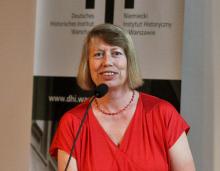You are here
Almut Bues

ALMUT BUES, Ph.D, is a Fellow of the German Historical Institute in Warsaw. She was previously a Fellow of the German Historical Institutes in Rome and London, and Lecturer at the University of Warsaw. Her research focuses on religion and politics in early modern central Europe, in particular on Poland-Lithuania, on processes of state and nation-building and on cultural history. Her major publications include Das Herzogtum Kurland und der Norden der polnisch-litauischen Adelsrepublik im 16. und 17. Jahrhundert. Möglichkeiten von Integration und Autonomie, Gießen 2001; Historia Niemiec XVI-XVIII wieku [Deutsche Geschichte 16. bis 18. Jahrhundert], Warszawa 1998 and Die Jagiellonen. Herrscher zwischen Ostsee und Adria (Stuttgart, Berlin, Köln, 2010). She has edited 9 volumes and has published many articles in English, German, Polish and Russian, on among subjects Eleonora Gonzaga, Holy Roman Empress, and Hedwig Sophie von Hessen-Kassel and her sister Luise Charlotte von Kurland.
Bues’s research centres upon the Polish princesses Zofia Jagiellonka (1522-1575), who married Heinrich II the Younger, Duke of Braunschweig-Wolfenbüttel (1489-1568), in 1556 and her sister Katarzyna Jagiellonka (1526-1583), who married Duke Johan of Finland (later Johan III, King of Sweden, 1537-1592) in 1562. Zofia and Katarzyna’s mother Bona Sforza (1493/4-1557), a Milanese princess, had imported Humanism from Italy to Poland, and a central focus of Bues’s research is whether the Jagiellonian princesses continued to spread Humanism into new territories. Previous scholarship has recognised that they transmitted intellectual contacts and ideas from Italy via Poland to the territories of Braunschweig-Wolfenbüttel (Zofia) and to Finland and Sweden (Katarzyna), but the extent to which they were able to graft new cultural norms and genres onto the culture they found there remains to be seen. In rectifying this, Bues will consider the extensiveness of the networks which the princesses established to facilitate cultural, religious and economic exchange. In doing so, she will unravel their interactions with their new domiciles and their country of origin, where their sister Anna had been elected queen, and with their half-sister Jadwiga (1513-1573), Electress of Brandenburg, and sister Izabela (1519-1559), Queen of Hungary, with whose heir they remained in contact after her death.
Zofia and Katarzyna’s cultural agency will be considered in three areas. 1) Their expansive art collections will be discussed as a means of interpreting dynastic exchange and cultural influence. Works in these collections originated in the Netherlands, Germany or Italy and then went to Hungary and back via Poland, before being transported to Sweden, Brandenburg and Braunschweig-Wolfenbüttel. One of the aims of the project is to chart the movements of these important art works and evaluate their influence. 2) Their architectural contributions. During Zofia’s widowhood she extended the castles of Schöningen and Herxheim and designed gardens. Katarzyna had a significant impact upon the Scandinavian ‘Vasa Renaissance’. Her influence on the many building projects during Johan’s reign will be studied (the royal palace in Stockholm, Turku castle, and Borgholm castle) for which Italian, Flemish and German master builders, painters and stucco workers were imported. 3) Their religious influence. Both were Catholics who married Protestants. While Zofia is said to have converted to Lutheranism, Katarzyna’s Catholicism had political consequences: the liturgy in Sweden drew closer to Catholic practices and the Jesuits got a foothold in the country. The Catholic education of her children also had political consequences for Europe, as it enabled her son Zygmunt (III) to become King of Poland.


